
kubeflow 是 google 开源的一个基于 kubernetes 的 ML workflow 平台,其集成了大量的机器学习工具,比如用于交互性实验的 jupyterlab 环境,用于超参数调整的 katib,用于 pipeline 工作流控制的 argo workflow等。作为一个“大型工具箱”集合,kubeflow 为机器学习开发者提供了大量可选的工具,同时也为机器学习的工程落地提供了可行性工具。
当然,由于 kubeflow 主要是 google 在主导,虽然其作为一个开源项目,但在很多选型上都和 google 自家产品深度绑定,比如 google 自己的存储工具 gstuil 作为一等公民,镜像仓库地址也大多是 grc.io这样的google自己的镜像仓库地址。
安装部署关于 kubeflow 的安装部署如果没有比较好的外网访问环境的话,大家可以参考我开源的一个project,专门做国内manifest,镜像仓库都是采用阿里云镜像,在国内网络环境下也能快速轻松安装部署:
git clone https://github.com/shikanon/kubeflow-manifests.git cd kubeflow-manifests python install.py
安装完成后查看等待所有 pod running。
$ kubectl get po -A NAMESPACE NAME READY STATUS RESTARTS AGE auth dex-6686f66f9b-54s96 1/1 Running 0 2h6m cattle-system cattle-cluster-agent-5f695c79c-x9ql7 1/1 Running 0 3h cert-manager cert-manager-9d5774b59-4xjmk 1/1 Running 0 2h23m cert-manager cert-manager-cainjector-67c8c5c665-nmcp6 1/1 Running 0 2h23m cert-manager cert-manager-webhook-75dc9757bd-z2k5c 1/1 Running 1 2h23m fleet-system fleet-agent-7d959597cb-q8ckq 1/1 Running 0 3h istio-system authservice-0 1/1 Running 0 2h23m istio-system cluster-local-gateway-66bcf8bc5d-j9kvp 1/1 Running 0 2h23m istio-system istio-ingressgateway-85b49c758f-l4hgc 1/1 Running 0 2h22m istio-system istiod-5ff6cdbbcd-2v5kj 1/1 Running 0 2h23m knative-eventing broker-controller-5c84984b97-86zkx 1/1 Running 0 2h23m knative-eventing eventing-controller-54bfbd5446-rx9ll 1/1 Running 0 2h23m knative-eventing eventing-webhook-58f56d9cf4-bnq9q 1/1 Running 0 2h23m knative-eventing imc-controller-769896c7db-kzjv6 1/1 Running 0 2h23m knative-eventing imc-dispatcher-86954fb4cd-9b6gz 1/1 Running 0 2h23m knative-serving activator-75696c8c9-9c5ff 1/1 Running 0 2h23m knative-serving autoscaler-6764f9b5c5-2gwqj 1/1 Running 0 2h23m knative-serving controller-598fd8bfd7-bpn5k 1/1 Running 0 2h23m knative-serving istio-webhook-785bb58cc6-ts9f2 1/1 Running 0 2h23m knative-serving networking-istio-77fbcfcf9b-pg26h 1/1 Running 0 2h23m knative-serving webhook-865f54cf5f-rzpjf 1/1 Running 0 2h23m kube-system coredns-5644d7b6d9-hwwnr 1/1 Running 0 3h1m kube-system coredns-5644d7b6d9-zds92 1/1 Running 0 3h1m kube-system etcd-kubeflow-control-plane 1/1 Running 0 3h kube-system kindnet-8tvm5 1/1 Running 0 3h1m kube-system kindnet-zkmkq 1/1 Running 0 3h1m kube-system kube-apiserver-kubeflow-control-plane 1/1 Running 0 3h kube-system kube-controller-manager-kubeflow-control-plane 1/1 Running 0 3h kube-system kube-proxy-c8zn7 1/1 Running 0 3h1m kube-system kube-proxy-k7b8c 1/1 Running 0 3h1m kube-system kube-scheduler-kubeflow-control-plane 1/1 Running 0 3h kubeflow admission-webhook-deployment-6fb9d65887-pzvgc 1/1 Running 0 2h22m kubeflow cache-deployer-deployment-7558d65bf4-jhgwg 2/2 Running 1 2h6m kubeflow cache-server-c64c68ddf-stz72 2/2 Running 0 22m kubeflow centraldashboard-7b7676d8bd-g2s8j 1/1 Running 0 2h7m kubeflow jupyter-web-app-deployment-66f74586d9-scbsm 1/1 Running 0 2h5m kubeflow katib-controller-77675c88df-mx4rh 1/1 Running 0 2h22m kubeflow katib-db-manager-646695754f-z797r 1/1 Running 0 2h22m kubeflow katib-mysql-5bb5bd9957-gbl5t 1/1 Running 0 2h22m kubeflow katib-ui-55fd4bd6f9-r98r2 1/1 Running 0 2h22m kubeflow kfserving-controller-manager-0 2/2 Running 0 2h22m kubeflow kubeflow-pipelines-profile-controller-5698bf57cf-btpn5 1/1 Running 0 22m kubeflow metacontroller-0 1/1 Running 0 2h7m kubeflow metadata-envoy-deployment-76d65977f7-rmlzc 1/1 Running 0 2h7m kubeflow metadata-grpc-deployment-697d9c6c67-j6dl2 2/2 Running 3 2h7m kubeflow metadata-writer-58cdd57678-8t6gw 2/2 Running 1 2h7m kubeflow minio-6d6784db95-tqs77 2/2 Running 0 2h7m kubeflow ml-pipeline-85fc99f899-plsz2 2/2 Running 1 2h7m kubeflow ml-pipeline-persistenceagent-65cb9594c7-xvn4j 2/2 Running 1 2h7m kubeflow ml-pipeline-scheduledworkflow-7f8d8dfc69-7wfs4 2/2 Running 0 2h7m kubeflow ml-pipeline-ui-5c765cc7bd-4r2j7 2/2 Running 0 2h7m kubeflow ml-pipeline-viewer-crd-5b8df7f458-5b8qg 2/2 Running 1 2h7m kubeflow ml-pipeline-visualizationserver-56c5ff68d5-92bkf 2/2 Running 0 2h7m kubeflow mpi-operator-789f88879-n4xms 1/1 Running 0 2h22m kubeflow mxnet-operator-7fff864957-vq2bg 1/1 Running 0 2h22m kubeflow mysql-56b554ff66-kd7bd 2/2 Running 0 2h7m kubeflow notebook-controller-deployment-74d9584477-qhpp8 1/1 Running 0 2h22m kubeflow profiles-deployment-67b4666796-k7t2h 2/2 Running 0 2h22m kubeflow pytorch-operator-fd86f7694-dxbgf 2/2 Running 0 2h22m kubeflow tensorboard-controller-controller-manager-fd6bcffb4-k9qvx 3/3 Running 1 2h22m kubeflow tensorboards-web-app-deployment-78d7b8b658-dktc6 1/1 Running 0 2h22m kubeflow tf-job-operator-7bc5cf4cc7-gk8tz 1/1 Running 0 2h22m kubeflow volumes-web-app-deployment-68fcfc9775-bz9gq 1/1 Running 0 2h22m kubeflow workflow-controller-5449754fb4-tdg2t 2/2 Running 1 22m kubeflow xgboost-operator-deployment-5c7bfd57cc-9rtq6 2/2 Running 1 2h22m local-path-storage local-path-provisioner-58f6947c7-mv4mg 1/1 Running 0 3h1m访问控制
kubeflow 通过dex 进行鉴权服务,安装好kubeflow,打开本地浏览器,看到 dex 的登录验证框,输出账号密码:

这里的账号密码可以通过 dex 的 configmap 设置:
apiVersion: v1 data: config.yaml: | issuer: http://dex.auth.svc.cluster.local:5556/dex storage: type: kubernetes config: inCluster: true web: http: 0.0.0.0:5556 logger: level: "debug" format: text oauth2: skipApprovalScreen: true enablePasswordDB: true staticPasswords: - email: "admin@example.com" hash: "$2a$10$2b2cU8CPhOTaGrs1HRQuAueS7JTT5ZHsHSzYiFPm1leZck7Mc8T4W" username: "admin" userID: "08a8684b-db88-4b73-90a9-3cd1661f5466" staticClients: - idEnv: OIDC_CLIENT_ID redirectURIs: ["/login/oidc"] name: 'Dex Login Application' secretEnv: OIDC_CLIENT_SECRET kind: ConfigMap metadata: name: dex namespace: auth
email 就是我们登录的用户名,hash 就是我们的设置的密码,可以通过以下这段python代码来生成:
from passlib.hash import bcrypt import getpass print(bcrypt.using(rounds=12, ident="2y").hash(getpass.getpass()))组件功能介绍
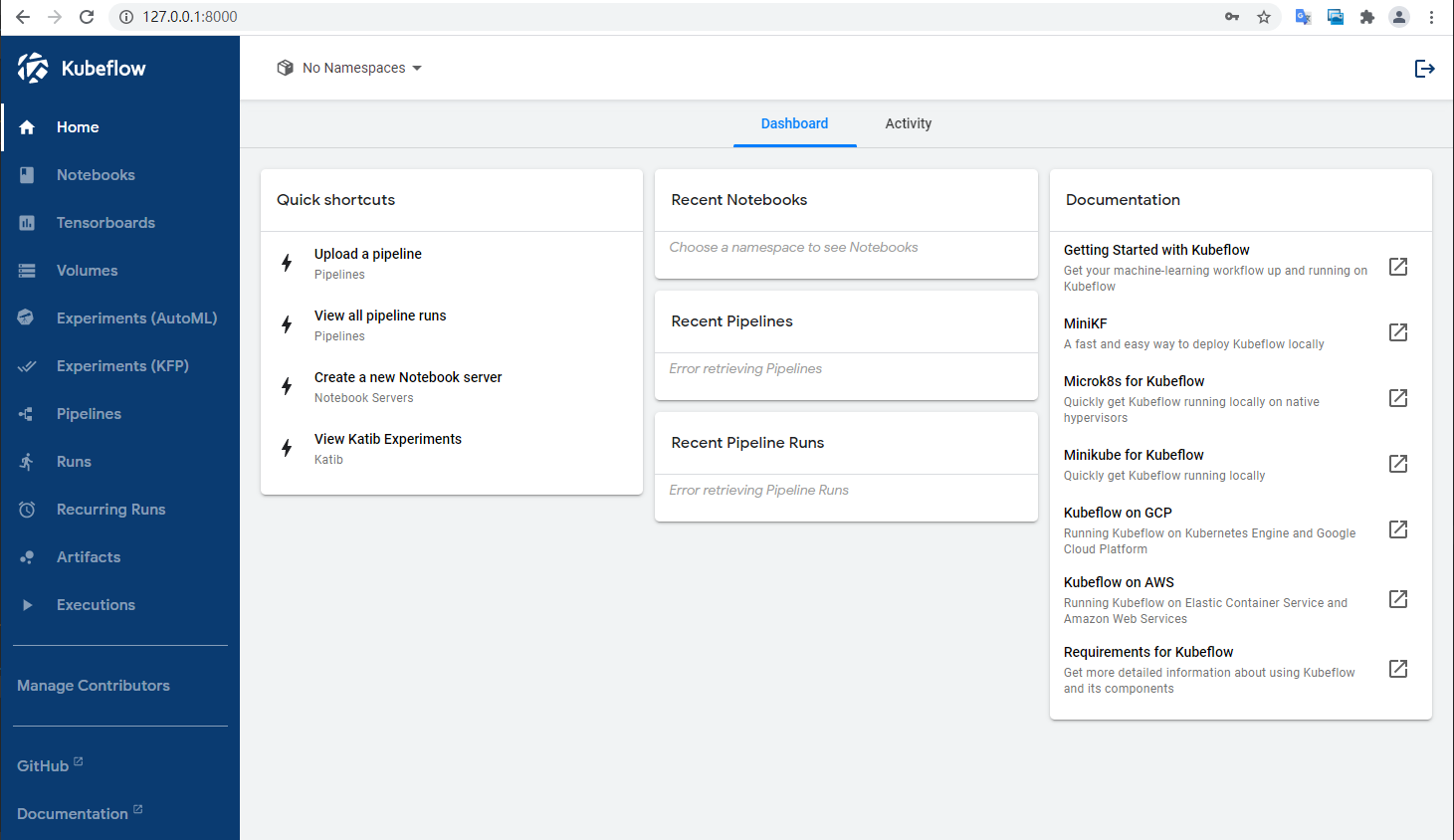
可以看到新版的kubeflow多了很多功能。
这里按模块介绍下 Kubeflow 的几个核心组件。
Notebook Servers,作为一个管理线上交互实验的记录工具,可以帮助算法人员快速完成算法实验,同时notebook server 提供了统一的文档管理能力。AutoML,提供自动化的服务,对特征处理、特征选择、模型选择、模型参数的配置、模型训练和评估等方面,实现了全自动建模,降低算法人员手动实验次数。Pipeline,提供一个算法流水线的工程化工具,将算法各流程模块以拓扑图的形式组合起来,同时结合 argo 可以实现 MLOps。Serverless,将模型直接发布成一个对外的服务,缩短从实验到生产的路径。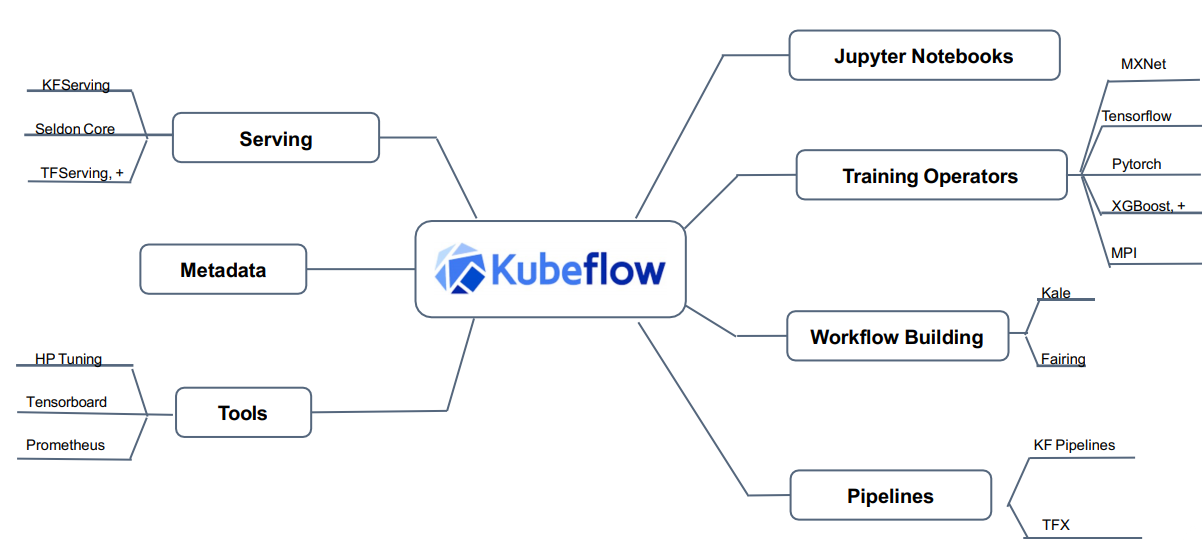
notebook 可以说是做机器学习最喜欢用到的工具了,完美的将动态语言的交互性发挥出来,kubeflow 提供了 jupyter notebook 来快速构建云上的实验环境,这里以一个我们自定义的镜像为例:

我们创建了一个test-for-jupyter名字的镜像,配置了一个 tensorflow 的镜像,点击启动,我们可以看到在kubeflow-user-example-com命名空间下已经创建我们的应用了:
kubectl get po -nkubeflow-user-example-com NAME READY STATUS RESTARTS AGE ml-pipeline-ui-artifact-6d7ffcc4b6-9kxkk 2/2 Running 0 48m ml-pipeline-visualizationserver-84d577b989-5hl46 2/2 Running 0 48m test-for-jupyter-0 0/2 PodInitializing 0 44s

创建完成后点击 connect 就可以进入我们创建的应用界面中了
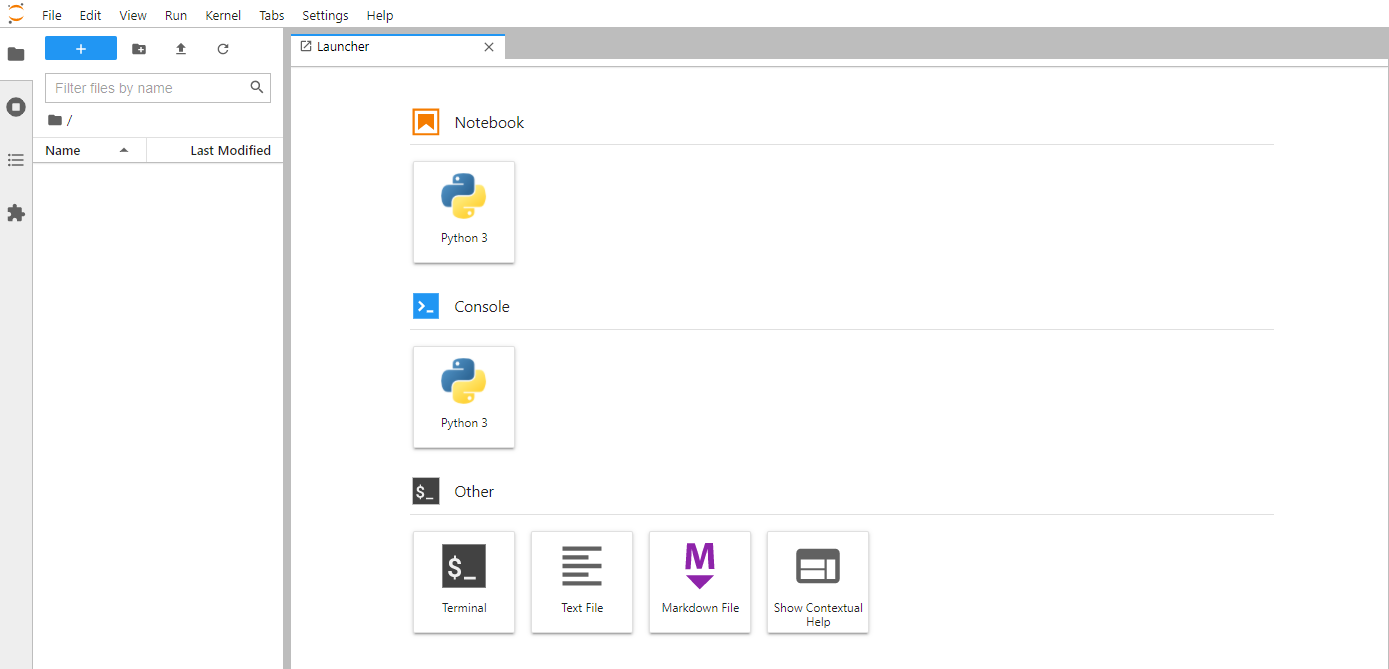

在 jupyterlab 环境中开发人员可以很方便的进行算法实验,同时由于运行在云上利用 k8s api甚至可以很方便构建k8s资源,比如通过 kfserving 创建一个ML服务。

AutoML 是机器学习比较热的领域,主要用来模型自动优化和超参数调整,这里其实是用的 Katib来实现的,一个基于k8s的 AutoML 项目,详细见https://github.com/kubeflow/katib。
Katib 主要提供了 超参数调整(Hyperparameter Tuning),早停法(Early Stopping)和神经网络架构搜索(Neural Architecture Search)
这里以一个随机搜索算法为例:
apiVersion: "kubeflow.org/v1beta1"
kind: Experiment
metadata:
namespace: kubeflow-user-example-com
name: random-example
spec:
objective:
type: maximize
goal: 0.99
objectiveMetricName: Validation-accuracy
additionalMetricNames:
- Train-accuracy
algorithm:
algorithmName: random
parallelTrialCount: 3
maxTrialCount: 12
maxFailedTrialCount: 3
parameters:
- name: lr
parameterType: double
feasibleSpace:
min: "0.01"
max: "0.03"
- name: num-layers
parameterType: int
feasibleSpace:
min: "2"
max: "5"
- name: optimizer
parameterType: categorical
feasibleSpace:
list:
- sgd
- adam
- ftrl
trialTemplate:
primaryContainerName: training-container
trialParameters:
- name: learningRate
description: Learning rate for the training model
reference: lr
- name: numberLayers
description: Number of training model layers
reference: num-layers
- name: optimizer
description: Training model optimizer (sdg, adam or ftrl)
reference: optimizer
trialSpec:
apiVersion: batch/v1
kind: Job
spec:
template:
spec:
containers:
- name: training-container
image: docker.io/kubeflowkatib/mxnet-mnist:v1beta1-45c5727
command:
- "python3"
- "/opt/mxnet-mnist/mnist.py"
- "--batch-size=64"
- "--lr=${trialParameters.learningRate}"
- "--num-layers=${trialParameters.numberLayers}"
- "--optimizer=${trialParameters.optimizer}"
restartPolicy: Never这里以一个简单的神经网络为例,该程序具有三个参数 lr, num-layers, optimizer,采用的算法是随机搜索,目标是最大化准确率(accuracy)。
可以直接在界面中填上yaml文件,然后提交。
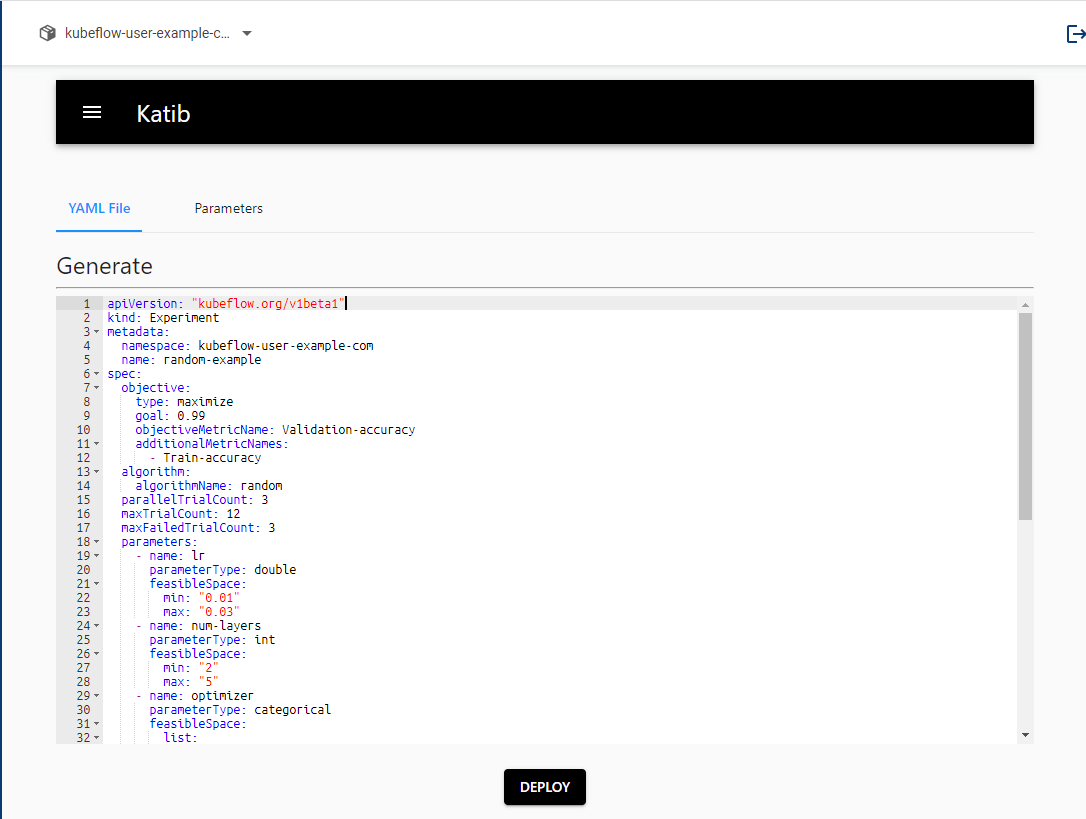
完成后会生成一张各参数和准确率的关系图和训练列表:
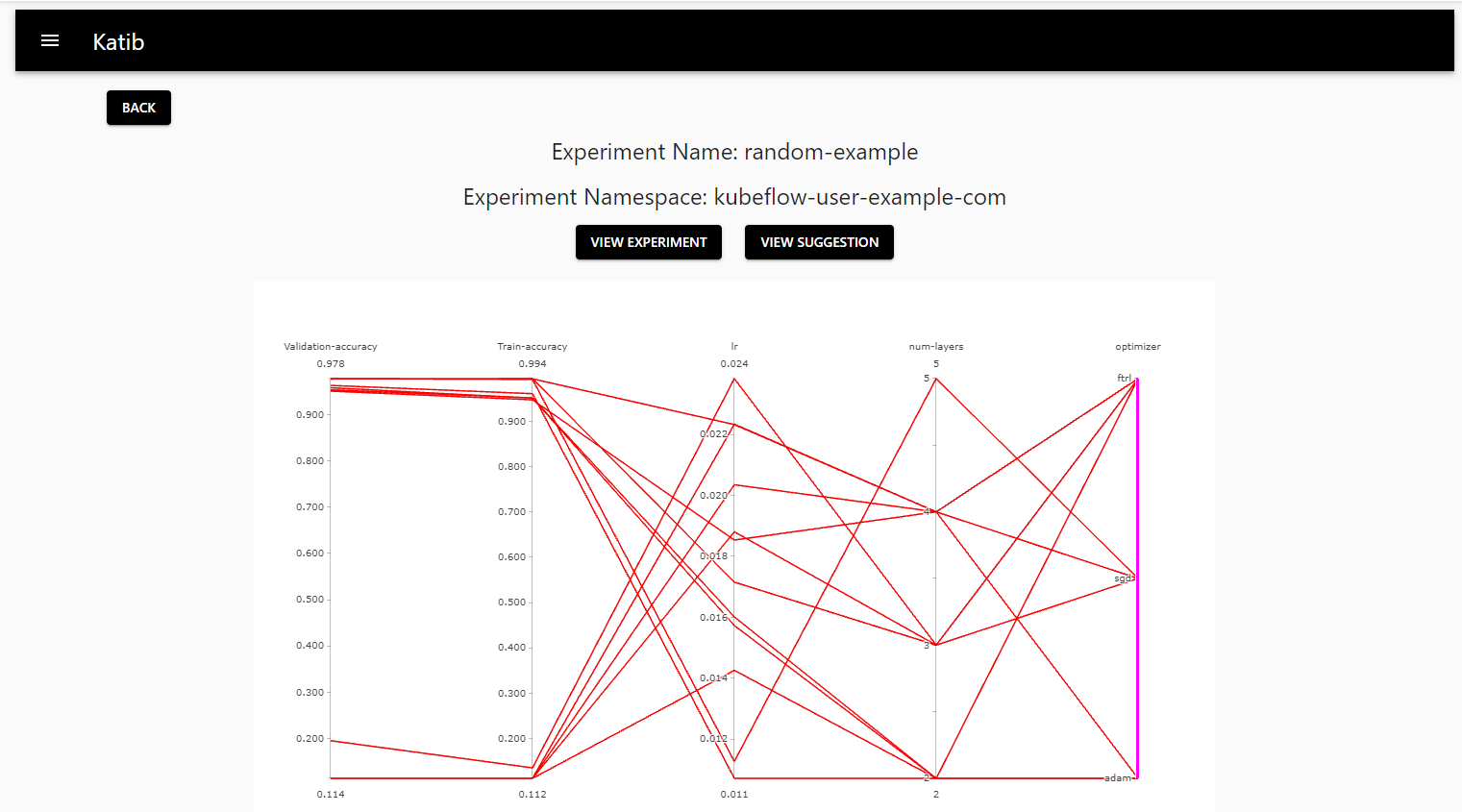

experiments 为我们提供了一个可以创建实验空间功能, pipeline 定义了算法组合的模板,通过 pipeline 我们可以将算法中各处理模块按特定的拓扑图的方式组合起来。
这里可以看看官方提供的几个 pipeline 例子:
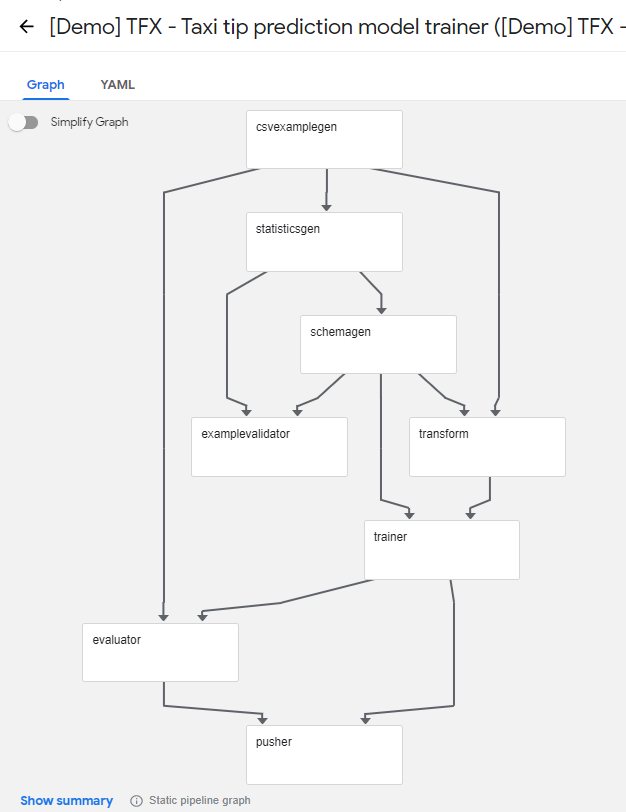

kubeflow pipeline 本质是基于 argo workflow 实现,由于我们的kubeflow是基于kind上构建的,容器运行时用的containerd,而workflow默认的pipeline执行器是docker,因此有些特性不兼容,这块可以见 argo workflow 官方说明:https://argoproj.github.io/argo-workflows/workflow-executors/。
这里我是把 workflow 的 containerRuntimeExecutor 改成了 k8sapi。但 k8sapi 由于在 workflow 是二级公民,因此有些功能不能用,比如 kubeflow pipeline 在 input/output 的 artifacts 需要用到 docker cp 命令,可以参考这个issue: https://github.com/argoproj/argo-workflows/issues/2685#issuecomment-613632304
由于以上原因 kubeflow 默认给的几个案例并没有用 volumes 是无法在 kind 中运行起来,这里我们基于 argo workflow 语法自己实现一个 pipeline
基于pipeline构建一个的工作流水第一步,构建一个 workflow pipeline 文件:
apiVersion: argoproj.io/v1alpha1
kind: Workflow
metadata:
generateName: kubeflow-test-
spec:
entrypoint: kubeflow-test
templates:
- name: kubeflow-test
dag:
tasks:
- name: print-text
template: print-text
dependencies: [repeat-line]
- {name: repeat-line, template: repeat-line}
- name: repeat-line
container:
args: [--line, Hello, --count, '15', --output-text, /gotest/outputs/output_text/data]
command:
- sh
- -ec
program_path=$(mktemp)
printf "%s" "$0" "$program_path"
python3 -u "$program_path" "$@"
def _make_parent_dirs_and_return_path(file_path: str):
import os
os.makedirs(os.path.dirname(file_path), exist_ok=True)
return file_path
def repeat_line(line, output_text_path, count = 10):
'''Repeat the line specified number of times'''
with open(output_text_path, 'w') as writer:
for i in range(count):
writer.write(line + '\n')
import argparse
_parser = argparse.ArgumentParser(prog='Repeat line', description='Repeat the line specified number of times')
_parser.add_argument("--line", dest="line", type=str, required=True, default=argparse.SUPPRESS)
_parser.add_argument("--count", dest="count", type=int, required=False, default=argparse.SUPPRESS)
_parser.add_argument("--output-text", dest="output_text_path", type=_make_parent_dirs_and_return_path, required=True, default=argparse.SUPPRESS)
_parsed_args = vars(_parser.parse_args())
_outputs = repeat_line(**_parsed_args)
image: python:3.7
volumeMounts:
- name: workdir
mountPath: /gotest/outputs/output_text/
volumes:
- name: workdir
persistentVolumeClaim:
claimName: kubeflow-test-pv
metadata:
annotations:
- name: print-text
container:
args: [--text, /gotest/outputs/output_text/data]
command:
- sh
- -ec
program_path=$(mktemp)
printf "%s" "$0" "$program_path"
python3 -u "$program_path" "$@"
def print_text(text_path): # The "text" input is untyped so that any data can be printed
'''Print text'''
with open(text_path, 'r') as reader:
for line in reader:
print(line, end = '')
import argparse
_parser = argparse.ArgumentParser(prog='Print text', description='Print text')
_parser.add_argument("--text", dest="text_path", type=str, required=True, default=argparse.SUPPRESS)
_parsed_args = vars(_parser.parse_args())
_outputs = print_text(**_parsed_args)
image: python:3.7
volumeMounts:
- name: workdir
mountPath: /gotest/outputs/output_text/
volumes:
- name: workdir
persistentVolumeClaim:
claimName: kubeflow-test-pv
metadata:
annotations: argo workflow 的语法可以参考:https://argoproj.github.io/argo-workflows/variables/
这里我们定义了两个任务 repeat-line 和 print-text, repeat-line 任务会将生产结果写入 kubeflow-test-pv 的 PVC 中, print-text 会从 PVC 中读取数据输出到 stdout。
这里由于用到 PVC,我们需要先在集群中创建一个kubeflow-test-pv的PVC:
apiVersion: v1 kind: PersistentVolumeClaim metadata: name: kubeflow-test-pv namespace: kubeflow-user-example-com spec: accessModes: - ReadWriteOnce resources: requests: storage: 128Mi
第二步,定义好 pipeline 文件后可以创建pipeline:
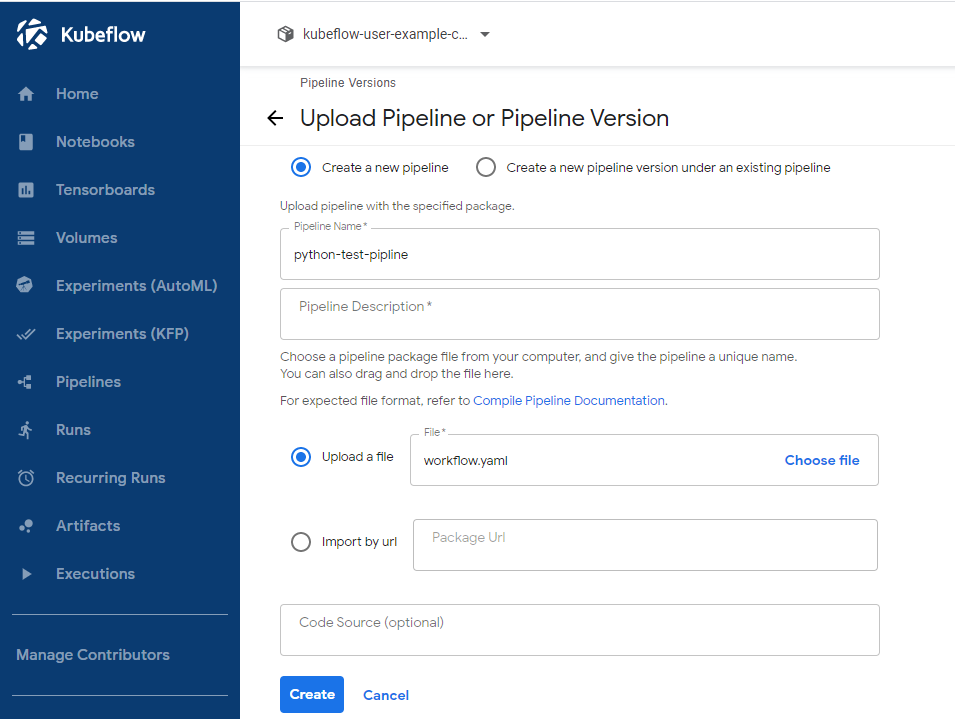
第三步,启动一个pipeline:

启动 pipeline 除了单次运行模式 one-off,也支持定时器循环模式 Recurring,这块可以根据自己的需求确定。
查看运行结果:

运行完后,可以将实验进行归档(Archived)。
关于 MLOps 的一点思考我们来看一个简单的 ML 运作流程:
这是一个 google 提供的 level 1 级别的机器学习流水线自动化,整个流水线包括以下几部分:
构建快速算法实验的环境(experimentation),这里的步骤已经过编排,各个步骤之间的转换是自动执行的,这样可以快速迭代实验,并更好地准备将整个流水线移至生产环境,在这个环境中算法研究员只进行模块内部的工作。构建可复用的生产环境流水线,组件的源代码模块化,实验环境模块化流水线可以直接在 staging 环境和 production 环境中使用。持续交付模型,生产环境中的机器学习流水线会向使用新数据进行训练的新模型持续交付预测服务。基于上述功能描述我们其实可以基于 kubeflow 的 pipeline 和 kfserving 功能轻松实现一个简单的 MLOps 流水线发布流程。不过,值得注意的是,DevOps 本身并不仅仅是一种技术,同时是一种工程文化,所以在实践落地中需要团队各方的协同分阶段的落地。这块可以参考《MLOps: Continuous delivery and automation pipelines in machine learning》和《Hidden Technical Debt in Machine Learning Systems》
参考文献https://www.tensorflow.org/tutorials/quickstart/beginnerhttps://github.com/dexidp/dexhttps://github.com/kubeflow/kfserving/tree/master/docshttps://argoproj.github.io/argo-workflows/workflow-executors/https://github.com/shikanon/kubeflow-manifestshttps://argoproj.github.io/argo-workflows/variables/https://cloud.google.com/architecture/mlops-continuous-delivery-and-automation-pipelines-in-machine-learning背景 2020年9月16日 Snowflake成功IPO 交易首日市场估值达到704亿美元 募集资金3...
描述 你正在和你的朋友玩 猜数字 (Bulls and Cows)游戏:你写下一个数字让你的朋...
有很多人在听说大数据之后,会开始纠结JAVA与大数据的区别,甚至还在纠结Java和...
本文介绍了北京慧达天下如何使用运维编排OOS提高发布效率。 公司介绍 公司名称:...
TOP云 (west.cn)1月25日消息,近日,功夫贷宣布获得4000万人民币A轮融资,本轮...
本文由网易云音乐实时计算平台研发工程师岳猛分享,主要从以下四个部分将为大家...
作者 | 亮言 来源 | 阿里技术公众号 一 背景 订单状态流转是交易系统的最为核心...
我们知道效能提升 就是要应用系统方法实践和工具 通过它们改进技术、工程能力和...
约束与限制 只有运行中的云服务器云主机才允许用户登录。 Windows操作系统用户名...
hk 域名 哪里注册? .hk域名 在国内是可以注册的,只要提供了.hk 域名注册 服务...